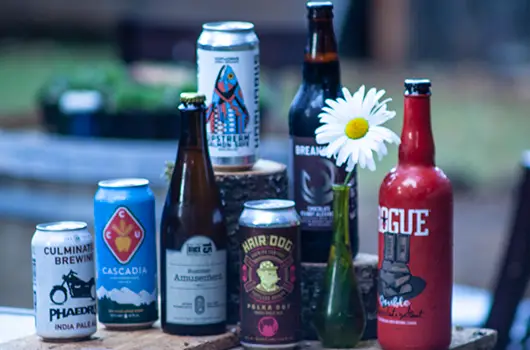Oregon Beer – It Really Is The Water!

Those old ads for Olympia Beer resonate for many in the Pacific Northwest. They tout the use of pristine artesian well water in brewing its product, proclaiming “It’s the water.” Simple and effective for a slogan, but how exactly does water affect beer?
Water makes up the largest percentage of beer (up to 97%). It can be taken for granted as simply the substance that extracts the flavors and compounds from grain and hops, and then acts as the environment for fermentation. But how well these processes work is affected by the water used for brewing. Therefore, characteristics such as mineral content, composition, and quality must be given due consideration when a brewer chooses a water source.
Water accounts for much of the flavor and perception of beer. Just as how a properly primed and stretched canvas matters to a painter, the water quality matters to a brewer. Anywhere quality is disregarded, the likelihood of failure increases. The profile and quality of water used for brewing is of great importance.
There are two primary factors for water to be suitable for brewing. First, it must be clear of biological, physical, and chemical contamination. Second, mineral content is important, as it will have an effect on pH, enzyme activity, hop perception, and clarity of the finished beer. Direct well, river, or lake sources can have wild variation in suitability, where commonly occurring elements like sulfur and iron can ruin beer. While municipal sources are reliably free of contamination, sanitizing chemicals such as chlorine can cause issues for brewers. The result is that brewers often must purify (boiling the chlorine out, for example), treat, or purchase purified water.
Minerals in water are numerous and many lend no effect to beer. The minerals that brewers are most concerned with are salts, calcium, carbonate, sulfate, and certain trace minerals used as yeast nutrients, such as zinc. Greater concentration of minerals can have negative effects such as inhibiting yeast and lending metallic flavors to beer. Absence of minerals, such as in distilled water, is unsuitable as it lacks supportive minerals and inhibits enzymes and yeast.

With an understanding of beer production and flavor, brewers add certain minerals which benefit the beer on various levels. For example, calcium, a necessary yeast nutrient, is added to beer in the form of gypsum and calcium carbonate. This increases the presence of ions, which interact with other ingredients to form flavor, chemical, and biological reactions within beer.
The major brewing centers around the world reveal a correlation between favored style and water composition. Entire styles are accountable to the profile of water. Generally, softer waters favor the production of lager and darker ales, while harder waters favor paler styles with more hop presence. The hard water of Burton-On-Trent in England led to the original popularity of India Pale Ale, while the round, malty Bohemian Pilsners out of Pilzen in the Czech Republic are attributed to the region’s soft water. London’s soft water yields an affinity for round, drinkable porters and stouts. Vienna’s hard water delivers an extra bite to their hoppy lagers. Mexico City, with nearly the same water profile as Vienna, is well known for classic examples of Vienna lagers.

It may come as no surprise that western Oregon has an abundance of pristine water resources for brewers. Fed by snowmelt from the Cascades, the major Oregon municipalities enjoy soft water with a moderate pH level. Efforts to keep drinking water sources uncontaminated have been successful. This is an ideal circumstance for brewers. A hard water source would mean costly filtration of excess minerals, or limit the range of styles brewers could concoct. Oregon’s water sources allow brewers who seek to emulate the styles of the classic brewing regions to do so simply by adding small amounts of the appropriate minerals to the water used for brewing. Is it any wonder why so many great beer styles are produced in Oregon breweries?
When we consider the vibrant brewing culture in Oregon and the Pacific Northwest, we clearly need to bestow credit where it is so greatly deserved: to the water. To the rapidly growing brewing industry in Oregon, employing nearly 30,000 people, with an economic impact of almost $3 billion to Oregon’s economy: it’s the water. The Portland metro area currently has the most breweries (73) of any city in the world: it’s the water. For Oregon craft beer, it really is the water!





Leave a Reply